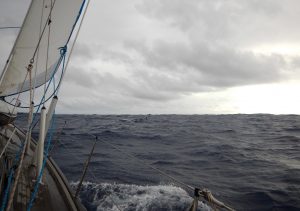South Indian Ocean Passage: Chagos to Rodrigues 2017
Alba has just completed the 1,100-mile passage from Chagos to Rodrigues, so here are my thoughts on the routing.
Published 8 years ago, updated 6 years ago


In 2017, the SE Trades had established by mid-May and six boats left Chagos in the last week of May. I’ve included their experiences as well – we all knew that this could be a tough up-wind passage, so we put a lot of thought into our routing.
Planning
The timing for the passage is that you want to leave after the cyclone season has finished, but early enough that the SE trade winds haven’t become too strong. The cyclone season in the Southern Indian Ocean officially ends at the end of April, but cyclones still occur in May. We elected to leave Chagos in the last week of May but kept a careful eye on any cyclonic development.
The general weather trend is that the wind varies in a direction from East to South and increases in strength from 10-15 knots at Chagos to at least 20-25 knots at Rodrigues. The general strategy is, therefore, to do most of the up-wind sailing in the first half of the passage where the winds are lighter and the seas are smaller.
Another complication is the Great Chagos Bank, which is a 100-mile wide atoll directly south of the Solomon Islands. A major decision is whether to sail to the west or east of this huge reef system.
If you head east, then you will be faced with a 60-mile motor-sail directly into the prevailing south-east winds and waves and then you’ll have to sail directly south for 80 miles down past Diego Garcia – again hard on the wind. You need a light wind start for this plan.
If you head west then the first 24 hours will be much more pleasant, but you’ll end up 120 miles further to the west than the eastern route, making the remainder of the passage harder on the wind by at least 10 degrees.
In past years, there have been strong south winds around Rodrigues, so most boats in 2017 headed for a waypoint 150 miles ENE of Rodrigues so that in the last 24 hours, we would not be beating into in the stronger winds. (In late May 2017, we experienced steady ESE 20 knot winds at the end, which was a lovely broad reach.)
Our Passage
Alba left Chagos on 22 May with SE 15-20 knot winds, so we chose to take the western route around the Great Chagos Bank. Our plan was to head south for 3 days, which would be a tough upwind beat in 15-20 knot winds. As the wind increased, we planned to bear away 10-15 degrees for the next three days and then have a down-wind run for the last 2 days when the wind would be strongest and the waves largest. (Our target waypoints were 07°34S 70°40E; 12°S 70°40E; 17°S 069°E; 19°S 066°E)
The first day around the west of the Great Chagos Bank was very nice with the 15-20 knot wind at 60° apparent. Days 2-4 were harder on the wind, sailing as close-hauled as we could manage. The wind was 20 degrees further south than the GRIB files forecast, so for days 3 & 4, we could only manage a course of 190°T. After four days, we were over half way at 14°S and had only given up 55 miles of easting.
The next two days were horrible. The wind picked up to 25-30 knots with sustained squalls every hour giving us 35-40 knots accompanied by heavy rain. The seas built up to 4 metres and were very confused. Fortunately, by this time, we were able to ease the sheets and steered a course of 215°T – 80° apparent. The worrying thing was that the GRIB forecast showed no ridges, troughs or lows – just a steady 20-25 knot wind, so we had no warning of this bad weather, which lasted 36 hours.
For the final two days, we had ESE 20 knots. Very steady and a pleasurable broad reach all the way to Rodrigues. It took us exactly 8 days. We downloaded GRIB files while underway and could see that we were going to get ESE winds at the end, which enabled us to “cut the corner” for the last three days, passing through 17°30S 67E.
So in summary:
Alba, a 42-foot monohull took 8 days. They took the western route and had 25-40 knots with 4-metre seas for 36 hours at around 15S. Turned towards Rodrigues at 17°30S 67°E. Bent a stanchion with preventer rope when had an unintentional gybe, running downwind in a 40-knot squall at night.
Hokulea, a 50-foot catamaran took 5.5 days. They took the western route, leaving at the same time as Alba and managed to miss the bad weather system. The max wind was 30 knots with 4-metre seas. Turned towards Rodrigues at 17°30S 67°E. No damage, but took lots of water over the deck.
Ngalawa, a 42-foot catamaran took 7 days. They took the eastern route, motoring into 10-15 knots with 2-metre seas for 12 hours and they were able to sail down to Diego Garcia. The max wind was 40 knots in short 15-minute squalls with 3.5-metre seas. Turned towards Rodrigues at 15°S. No damage, but took lots of water over the deck.
Relax, a 42-foot catamaran took 7.8 days. Sailed with Ngalawa, so had the same route and sea conditions. Lost a length of trim on their bow in the heavy seas and took in water in two hatches that weren’t completely closed.
Endymion, a 34-foot monohull, single-hander took 11 days. He took the western route and had trouble maintaining a south course, but managed to sail 40 miles east of the rhumb line. Max winds about force 8 (he doesn’t have an anemometer), max seas 4 metres, confused. Had trouble starting an engine at end of a trip – had a blockage in the pipe exiting the fuel tank, probably from being bounced about so much.
Cataya, a 53-foot monohull, single-hander sailed directly from Gan, Maldives and took 9 days. Sailed south to a point 80 miles east of Diego Garcia and then stayed comfortably on the wind, trying to retain easting until 100 miles east of Rodrigues. Max winds 35-40 knots in prolonged squalls. Seas 3.5 metres, no damage.
Neville Howarth
Yacht Alba
Related to following destinations: BIOT (Chagos), Mauritius
Related to the following Cruising Resources: Indian Ocean, Routing




Sounds similar to our 2018 trip…left at about same time, about the same experience. Wet trip. Big seas. Had water come into places we never had had water before. Many people agreed that 30-40 knots of wind in this ocean seemed to create bigger waves than in past oceans.